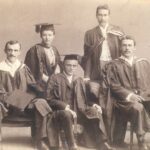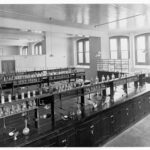Before and after the arrival of Europeans, Aboriginal peoples had a well-developed cultural understanding and practical knowledge of plants, animal behaviour, local geology and meteorological conditions. Information they provided was frequently vital to the success – and even survival – of early European navigators and explorers.
Interest in the natural history of South Australia led to the formation of a South Australian Literary and Philosophical Society in London in 1834. Early settlers established collections, sending natural history specimens back to Europe. Many demonstrated broad interests that contrast with more specialised twentieth-century studies.
Evolution of the Profession in South Australia
Following early reliance on the ‘gentleman scientist’ and amateur collector, trained scientists were appointed to responsible positions in the 1850–60s, a watershed period in Australian science. Under G.W. Francis, first director of Adelaide’s Botanic Gardens (1855–65) and its second director Richard Schomburgk (1865–91), the Gardens undertook agricultural and horticultural research. Geological and mineralogical studies were advanced by Johannes Menge, Boyle Travis Finniss, T. Burr, J.C. Dixon, Carl Zachariae and Julian Tenison Woods, and by Benjamin Babbage’s appointment in 1851 as government geologist and mineral surveyor. The Adelaide Philosophical Society (later the Royal Society of South Australia) was formed in 1853. Charles Todd filled the dual posts of astronomer and superintendent of post and telegraphs from 1855. A library, museum and lecture rooms were housed in the South Australian Institute building, opened in 1861. Important contributions from men of German origin, such as Menge, Schomburgk, F.E.H.W. Krichauff, C.W.L. Muecke and M.P.F. Basedow, included support for establishment of Roseworthy Agricultural College (1883) and Australia’s first properly funded Forestry Board (1875).
The Establishment of the University of Adelaide and the Growth of Science
A significant advance in the hitherto utilitarian and localised profile of South Australian science came with the University of Adelaide’s foundation in 1874. Arriving in 1875 as professor of Natural Science, Ralph Tate invigorated the local scientific community. During 1884–85 Edward Rennie became Angas Professor of Chemistry, Archibald Watson was appointed the first Elder Professor of Anatomy and Edward Charles Stirling lecturer in physiology; professional training in medicine began and Edith Dornwell became first science graduate and first woman graduate. Stirling, well-regarded in zoology, anthropology and other sciences, became director of the South Australian Museum in 1895 and professor of physiology in 1900. John Burton Cleland became Marks Professor of Bacteriology and Pathology in 1920. A skilled pathologist, Cleland’s greatest contributions were in botany, ornithology and anthropology. Outstanding medical researchers included J.D. Davies (hydatid disease), and later overseas Howard Florey and Hugh Cairns. The Institute of Medical and Veterinary Science was founded in 1938.
Establishment of the Council for Scientific and Industrial Research (later CSIRO)
Ecological research, especially in arid zones, gained support from T.G.B. Osborn, first professor of botany, vegetable pathology and parasitology (1912–28). Adelaide University’s Waite Agricultural Research Institute was established in 1924 under Waite Professor of Agriculture, A.E.V. Richardson. J.A. Prescott became professor of agricultural chemistry and in 1926 simultaneously chief of the Division of Soils of the newly formed Council for Scientific and Industrial Research (CSIR, later CSIRO). Cooperation with the state Department of Agriculture stimulated soil research. Research on trace elements, of great importance in agriculture and pastoralism, exemplified the value of interdisciplinary teamwork. Integration of soil science, pedology and ecology in the later twentieth century enabled research into water and land erosion and soil salinity.
Growth of the Sciences in the Twentieth Century
CSIR established a Division of Animal Nutrition in Adelaide in 1927, under Professor Brailsford Robertson (notable for producing the first batch of insulin in Australia in 1923), later reorganised and renamed the Division of Human Nutrition. Significant research included Hedley Marston’s coast disease program and Basil Hetzel’s work on thyroid disorders and human iodine deficiency.
As in the biological sciences, pure and applied geological research went hand in hand. Students of Douglas Mawson (who followed Tate and Walter Howchin at the university) became field geologists for both the South Australian Mines Department and private companies, undertaking research into sources of water, minerals, natural gas and oil, all further developed after 1945.
Mathematics and physics produced names of international note. Horace Lamb, appointed first professor of mathematics in 1875, had a distinguished career in applied mathematics, working on hydrodynamics, elastic vibrations and electromagnetism. From 1885 he was followed by William Henry Bragg, who achieved fame in the field of X-ray research and, with his son W. Lawrence Bragg, was awarded a Nobel Prize in 1915. Their outstanding physics students included Mark Oliphant.
During 1939–45 the physics department under Kerr Grant supported the war effort, designing and manufacturing optical munitions, while the chemistry department helped produce drugs for the armed forces. Science had been relatively poorly funded, and the post-war years saw significantly increased resources. University research programs expanded dramatically in the 1950s under Vice-Chancellor A.P. Rowe.
In the physical sciences Professor L.G.H. Huxley began projects in atmospheric physics while applied mathematics came to the fore in research at the Commonwealth’s Weapons Research Establishment, later the Defence Science and Technology Organization, at Salisbury north of Adelaide. In 1966 WRESAT, the first Australian-made orbital satellite, carried equipment prepared by Professor John Carver and Dr Brian Horton to study ultra-violet light reflected in the upper atmosphere. Professor Ken McCracken, appointed 1965, established a cosmic ray research group in the new field of X-ray astronomy. Cosmic ray research has continued, with an increasing international element.
Between 1955 and 1980 D.O. Jordan, G.M. Badger and A.L.J. Beckwith developed significant research in chemistry: Jordan established an important school of polymer chemistry, Badger’s work included the organic chemistry of aromatic compounds and research on the synthesis of polynuclear heterocyclic molecules, while Beckwith worked on free radicals. From the 1970s inorganic reaction mechanisms and molecular encapsulation studies by means of nuclear mass resonance spectrometry, organo-metallic chemistry and mass spectrometry in its application to the study of natural and synthetic molecules have been major research areas. Applied chemistry found a niche at the Ian Wark Institute of Applied Chemistry, University of South Australia.
In the 1980s Adelaide became a pre-eminent Australian centre for biochemistry and molecular biology involving research on genes and proteins. Methods were developed to improve the structure and production of wool and an important stem cell technology centre led to the establishment of Bresagen, Adelaide’s first listed company derived from university research. There was also significant participation in the human genome project. Information technology and telecommunications, geology and geophysics, and botany, especially plant physiology and marine flora, are among other areas of research strength. Recent joint Adelaide University/CSIRO projects have embraced the chemistry of radioactivity, molecular wires (nano-technology), ion-chemistry, gastro-intestinal health/colon cancer links, transgenic research, development of antibiotics from amphibians, diabetes and cardiovascular issues, and a new test for chromosome damage, now an internationally recognised standard for assessing the toxic effects of chemical radiation and dietary deficiencies.
Founding of Flinders University and the University of South Australia
The founding of Flinders University (1964) significantly increased the total population of South Australian research scientists, and their opportunities for collaborative work. Important contributions have been made at Flinders in theoretical physics, experimental biology, plant physiology, and various branches of medical science, while Flinders also introduced to South Australia the disciplines of meteorology and oceanography, among others. At Flinders as elsewhere, significant research in the physical sciences, medical science, food, wine and nutrition is now frequently undertaken in partnership with commerce and industry, as for instance involving sunscreen production, blood serum analysis, DNA sample storage, tidal level measurement and horticultural production. The University of South Australia has also been particularly successful in developing applied scientific research of direct commercial and industrial relevance; its staff have participated with their Adelaide and Flinders colleagues in the establishment of a suite of major Cooperative Research Centres and other designated scientific research centres during the past decade.
Increasing Collaboration and Interdisciplinary Research
In all fields of science, both pure and applied, the second half of the twentieth century saw a marked shift of emphasis from individual researchers to collaborative teamwork, often both interdisciplinary and multi-institutional. Perhaps the most striking local example is provided by developments at and alongside the Waite campus of Adelaide University, where Australia’s first chair in genetics was established and a long tradition of research excellence has aided horticulture, viticulture and agriculture, with impacts on cereal breeding of world-wide significance. There in the early 1990s Harold Woolhouse brought about an outstanding co‑location project, which has resulted not only in an expanded CSIRO presence, but also consolidated the major state government agricultural science laboratories and research staff on the Urrbrae/Waite precinct, as the South Australian Research and Development Institute.
Limited space has largely confined this entry to a survey of research in the field of natural and physical science, although there has been no lack of significant South Australian achievements in the broader range of engineering, technology and the social sciences, including economics, geography and psychology, to say nothing of anthropology, education, history, linguistics and political science. Science education, including efforts to raise community awareness of science, as through the work of the state’s Investigator Science and Technology Centre, is another important topic deserving more attention than it can receive here.






Comments